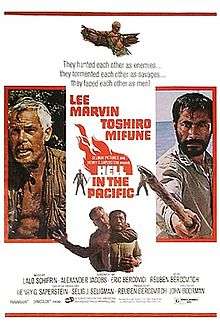Hell in the Pacific
| Hell in the Pacific | |
|---|---|
 Theatrical release poster | |
| Directed by | John Boorman |
| Produced by | Reuben Bercovitch |
| Written by |
Reuben Bercovitch Alexander Jacobs Eric Bercovici |
| Starring |
Lee Marvin Toshirō Mifune |
| Music by | Lalo Schifrin |
| Cinematography | Conrad Hall |
| Edited by | Thomas Stanford |
Production company | |
| Distributed by | Cinerama |
Release dates |
|
Running time | 103 minutes |
| Country | United States |
| Language |
English Japanese |
| Budget | $4,150,000[1] |
| Box office | $3,230,000[1] |
Hell in the Pacific is a 1968 World War II film starring Lee Marvin and Toshirō Mifune, the only two actors in the entire film. It was directed by John Boorman.[2] It looks at the importance of human contact and the bond which can form even between enemies if lacking other contact.
Plot
The film is a story of two soldiers, one American and the other Japanese, marooned on an uninhabited Pacific island, who, in order to survive, must accept their differences and work together, despite their two countries being at war. There are changes as to which man dominates the other and differences are put aside to build a raft to escape the island. Whilst they reach another larger island, which shows signs of having recently been a Japanese military base, it too is abandoned. Perhaps the film can be summarised by one line from Marvin on the second island: "for a moment there I thought you were a Jap".
Cast
- Lee Marvin as American Pilot
- Toshirō Mifune as Captain Tsuruhiko Kuroda
Production notes
The film contains little dialogue, and much like its predecessor – the film None but the Brave – is not dubbed or sub-titled, thus authentically portraying the frustration of restricted communication between the Japanese- and English-speaking. The film was entirely shot in the Rock Islands of Palau in the north Pacific Ocean, near the Philippines in the Philippine Sea.
The film was originally released with a rather abrupt ending, one that left many dissatisfied with the outcome of the struggle these men endured. The subsequent DVD release has an alternative ending, which while leaving the eventual destiny of the two ambiguous, was much more in line with the overall direction of the film.
Both actors served for their respective countries during the Pacific War. Marvin, who was in the US Marines, was wounded and received the Purple Heart during the Battle of Saipan in 1944. Mifune served in the Imperial Japanese Army Air Service.
Reception
The film was perhaps too close to the end of the Second World War to stem inevitable anti-Japanese sentiments from the American public (which is presumably partly the purpose of the film). Both actors were hugely respected in their own countries at the time (Marvin had recently won an oscar for Cat Ballou and Mifune was probably the most famous actor in Japan at the time). However, a largely dialogue-free and action-free film was too much to ask for great audience love, and neither actor was able to show their usual potential.
Box office
The film earned rentals of $1.33 million in North America and $1.9 million elsewhere. Because of the high costs involved, by 1973 the movie had recorded a loss of $4,115,000, making it one of the biggest money losers in the short history of ABC films.[1]
Critical reception
Toshiro Mifune also took on foreign assignments, but few did him justice. It was only John Boorman's Hell in the Pacific that captured something of his range, humour and power.
See also
References
- 1 2 3 "ABC's 5 Years of Film Production Profits & Losses", Variety, 31 May 1973 p 3
- ↑ Hell in the Pacific at the American Film Institute Catalog.
External links
| Wikimedia Commons has media related to Hell in the Pacific. |
- Hell in the Pacific at the American Film Institute Catalog
- Hell in the Pacific at the Internet Movie Database
- Hell in the Pacific at AllMovie
- Hell in the Pacific opening titles and first scene on YouTube
